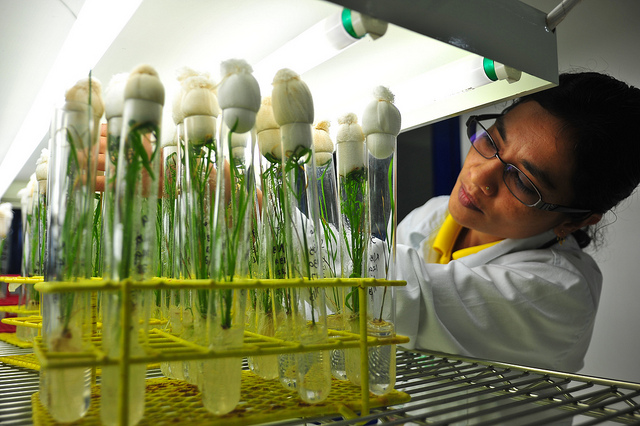The weight of global investment in science and technology is shifting. Strong R&D growth in countries like China, India, South Korea, Singapore and Malaysia means Asia is fast catching up to the traditional scientific centres of Europe, North America and Japan. This is a pivotal period.
Nowhere is this more evident than China. According to former Chinese President Hu Jintao, ‘China has set the goal to become an innovation-driven economy by 2020′. The Chinese are backing their rhetoric with action, with real growth in R&D spending exceeding 18% per annum since 2000.
Scientific research is now a truly global enterprise. The General Electric 2011 Global Innovation Barometer forecasts that 40% of global innovation over the next decade will be driven by collaboration across national and institutional boundaries. This is because research is conducted most efficiently when ideas, data, facilities, equipment, talent and risks are shared on a competitive basis. Despite that, the Government has made decisions in recent years to retreat from strategic collaborative engagement.
Past investments in science and scientific collaboration have made Australia a world-classknowledge producer, problem solver and therefore an attractive partner. But past performance is no guarantee of future success. While overseas representatives seek opportunities to engage, we’ve taken ourselves to the sidelines at this fertile time, unable to properly respond to collaborative requests or to initiate strategic engagements of our own.
In 15 years, the Australian middle class consumer market is likely to be less than 1% of the size of that in the Asia region. Our larger neighbours are eager to collaborate because our scientific capacity affords us a standing far greater than the size of our population or markets. Our decision to retreat doesn’t meet the expectations of our traditional collaborators in Europe and North America and is confusing the emerging scientific communities in Asia.
In Canberra today, over a dozen foreign embassies have science counsellors or attachés whose task is to join Australia’s research efforts with their national interests. Collaboration requires shared goals but, as a Parliamentary Committee found, our roughly $9 billion annual public science investment supports the local science base and some limited overseas activities, but little, if any, reciprocal impact abroad.
Nations such as China and Korea are part of a growing group of countries that’ve taken deliberate steps to strategically foster science collaboration. That’s because they know that this has a multiplier effect on their own domestic investment, leading to greater innovation, productivity and social wellbeing. The scientific community in Australia expects to be able to deliver similar benefits.
With 0.3% of the global population, Australia produces 3% of global research. Because of our standards and past commitment to international linkages, Australia has enjoyed strong ties to the remaining 97% of new research produced elsewhere. As the global balance of R&D investment and growth shifts, our existing ties are rapidly expiring.
As noted by Nobel Laureate Professor Brian Schmidt: ‘part of Australia continuing to succeed in the rapidly evolving world of science and technology is looking beyond our borders to work cooperatively with colleagues overseas’.
Government and industry must take steps to improve our international science engagement. The scientific community looks to Government to set out a clear strategy, backed by directing a small fraction (perhaps 0.25%) of our existing science budget specifically towards strategic international science engagement.
To gain situational awareness of what’s going on and planned in the 97% of the world research scene that doesn’t occur in Australia, we need an effective network of Science Counsellors and locally engaged staff at our posts. Since 1995, our network of posted Science Counsellors hasdropped from a peak of 16 in 1995 to part responsibility of a few posted staff today.
Recently, an overseas network, posted or locally engaged by the Department of Education, Employment and Workplace Relations, has been established to provide support for Australia’s education and training services. Education exports are important and value adding and deserving of strategic support. We could similarly benefit from investing in support for our strategic interests in scientific collaboration.
The USA 2010 Quadrennial Diplomacy and Development Review noted that ‘science and technology must be enlisted in an unprecedented fashion’. The US State Department backs this rhetoric with approximately 50 Foreign Service officers in their embassies, including several in China, to focus exclusively on environment, science, technology and health issues.
In contrast, Australia has a Counsellor and a Minister Counsellor for Education in China. As a matter of some urgency, we need to build an effective network. Scale alone suggests we ought to be proactive. The annual gross expenditure on R&D in Australia is approximately US$22 billion,compared with almost half a trillion expended by China ($220b), India (US$45b), Japan ($161b) and South Korea ($57b).
The Government’s laudable 2025 goal is to have ten of our universities in the world’s top 100. Given the importance of research and international outlook to such rankings, this is unlikely to happen without a science collaboration policy and the means to implement it.
Leveraging science and diplomacy not only amplifies and augments our domestic investment, but it also builds very strong bilateral relationships and contributes to broader foreign policy objectives. Key among the critical strategic opportunities facing our country is the choice to compete in the field of new knowledge (PDF). The science community seeks a Government policy in this important area.
We believe there’s a closing window of opportunity for Australia to maximise our intellectual contribution to the twenty-first century. Action to remain engaged and collaborative wouldn’t be a new initiative; it would be restoration of past successful policy.
Andrew Holmes is the Foreign Secretary, Australian Academy of Science. Image courtesy of Flickr user IRRI Images.
SOURCE
SOURCE

